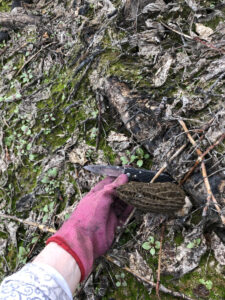Serendipity

Morels appear like magic.
A surprise morel mushroom sighting was a serendipitous find for Marion. It happened on May Day 2024, in an area of Winding Pathways we’re rewilding. While seeking blooming bluebells and emerging May Apples she spotted the delicious fungus poking through last year’s oak leaves. We’ve since found more. With Cedar Rapids Houby Days just around the corner it looks like a good season for morels.
We own about two acres. Our house, garden, and lawn occupy about half our land. The rest we’re gradually rewilding to its native vegetation. Although we sometimes discover vegetative surprises in our unsprayed lawn, the most delightful new plants appear in our property’s “back 40”.
Nature’s Resiliency
Newly emerging species remind us of nature’s resiliency. A few years ago, a derecho’s 140-mile-an-hour wind knocked down many of our mature trees. Much of our land was shady, but the 40-minute storm transformed it into a sunny landscape. We’ve since noticed a dramatic decline in shade-loving ferns and an increase in sun-loving Wing stem. Other plants are fading and rising as the years go by.
We recently read that archeologists had found 4,000-year-old mullein seeds in an Egyptian tomb. When planted, they sprouted! Lots of native plants may not have the ability to stay viable that long, but they remain down in the soil, perhaps for decades, waiting for the right ecological conditions. Then they rise as if by magic. Other plants can spread their seed widely. Ones that end up in just the right place also sprout seemingly magically.
Pause for Thought
Ecological mysteries give us pause for thought and reasons to marvel at nature’s resiliency. We don’t know if our morels had been in the soil for years or if a spore had landed there more recently. Either way, this spring brought perfect conditions for their growth, and they appeared.
Enjoying Nature’s Abundance
We carefully picked our mushrooms, consulted with an experienced neighbor, and enjoyed them after preparing them and simmering in butter.
We’ll keep watching for others to appear.
Where Do Morels Grow?
Morels live across the country and usually appear in April or May. Hunting them is a popular activity. For information check these websites
Rewilding Winding Pathways
We’re gradually rewilding about an acre of Winding Pathways. Although many believe this simply means “letting nature take its course” we know that’s not feasible today because so many invasive species stress native plants. We manage nature lightly as we rewild our land. Here’s what we do.
- Remove the worst invasive species including Japanese Barberry, Asian Honeysuckle, Multiflora Rose, and Asian Bittersweet. As soon as we spot one, we unleash the lopping shears and chop it off as close to the ground as possible.
- Replaced three areas of lawn with native prairie.
- Carefully use prescribed burns to encourage natives and discourage invasives.
Natural or Native is Not Always Desirable
Two native species belong in our rewilding areas, but we discourage them because of the misery they can cause. We just keep them away from pathways. Here are the culprits:
Poison Ivy: It’s an important and valuable native plant for wildlife. Poison Ivy’s early spring leaves are an almost iridescent red, and they glow bright red in autumn’s fading days. Birds and deer devour the berries. Cottontails love eating the foliage and stems. All good except the itching. Both Marion and Rich are allergic to it and don’t enjoy the awful rashes that result from close encounters. We stay away from poison ivy and don’t cut it but spot-spray those plants growing close to pathways.
Virginia Tickseed: This interesting native doesn’t seem to be used much by wildlife, and it’s rather attractive. Come fall it produces zillions of small burs that are nearly impossible to remove from our clothes. We chop off any we find growing close to paths.
- Morels’ distinctive shape. Credit Fitzgibbons
- Carefully cut or break off a morel. Credit Fitzgibbons
Finding morels was exciting. We’ll likely find plants new to us springing up in our wilder areas. Most won’t be edible like morels, but they are fascinating and are living examples of nature’s resiliency.



